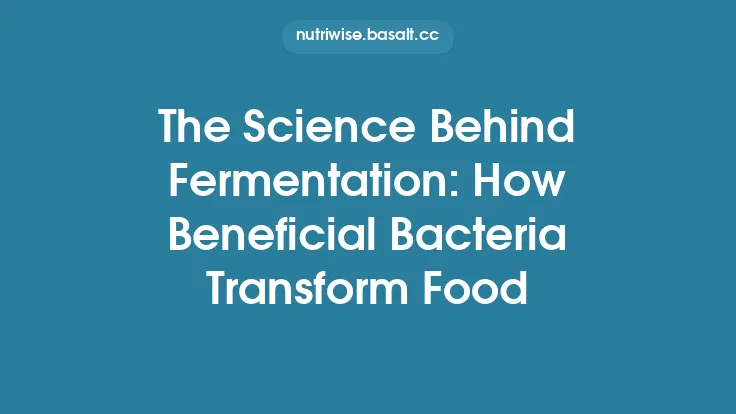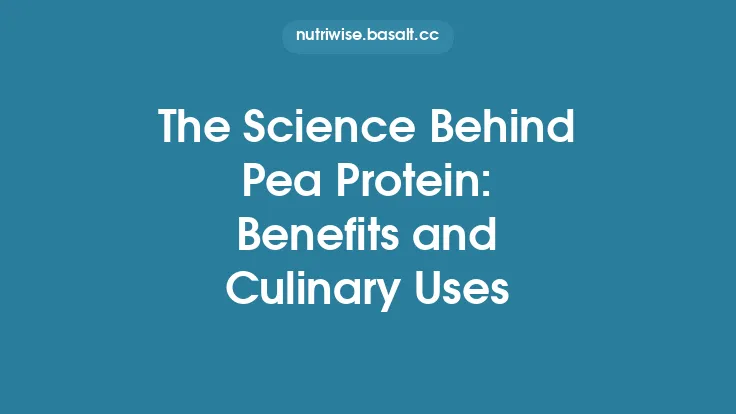Fermentation is one of humanity’s oldest food‑processing technologies, predating written history and spanning every continent. Long before the advent of modern chemistry, peoples around the world discovered that allowing certain foods to sit under controlled conditions produced flavors, textures, and aromas that could not be achieved by cooking alone. What began as a practical solution for preservation has, through centuries of trial and observation, become a sophisticated biochemical laboratory embedded in kitchens, cellars, and communal gathering places. The true power of traditional fermentation lies not merely in its ability to keep food edible, but in the profound chemical transformations that occur within the matrix of raw ingredients, driven by complex microbial consortia. These transformations enrich the food with nutrients that are more bioavailable, generate novel bioactive compounds, and alter macronutrient structures in ways that enhance the overall nutritional profile. Understanding the science behind these age‑old practices reveals why fermented foods have remained a timeless nutritional boost across cultures.
Microbial Communities: The Hidden Architects
At the heart of any fermentation are microorganisms—bacteria, yeasts, and occasionally molds—that colonize the substrate and orchestrate its conversion. Traditional fermentations typically rely on spontaneous inoculation, where microbes present on raw ingredients, in the environment, or on the surfaces of fermentation vessels initiate the process. Over time, cultures have been refined through back‑slopping (re‑using a portion of a previous batch) or the addition of starter cultures derived from earlier successful fermentations, creating a stable, predictable community.
These communities are rarely monocultures. Instead, they form syntrophic networks in which different species complement each other's metabolic needs. For example, lactic acid bacteria (LAB) such as *Lactobacillus spp. produce lactic acid, lowering pH and creating an environment that favors acid‑tolerant yeasts like Saccharomyces* spp., which in turn generate ethanol and carbon dioxide that can inhibit spoilage organisms. The dynamic balance among these groups determines the trajectory of the fermentation and the spectrum of metabolites produced.
Biochemical Transformations: From Raw to Rich
The metabolic activity of the microbial consortium drives a cascade of biochemical reactions that remodel the substrate’s composition:
- Carbohydrate catabolism – Simple sugars are fermented via glycolysis, yielding organic acids (lactic, acetic), ethanol, carbon dioxide, and a suite of minor metabolites.
- Proteolysis – Microbial proteases cleave complex proteins into peptides and free amino acids, some of which become precursors for flavor compounds or are directly absorbed.
- Lipolysis – Lipases hydrolyze triglycerides into free fatty acids and glycerol, providing substrates for further oxidation or esterification.
- Redox reactions – Electron transfer processes generate reduced compounds (e.g., NADH) that are re‑oxidized through the production of acids or alcohols, maintaining cellular energy balance.
These transformations not only preserve the food but also generate new nutrients and bioactive molecules that were absent or present only in trace amounts in the raw material.
Enzyme Activation and Nutrient Bioavailability
Traditional fermentation often activates endogenous plant enzymes that are otherwise dormant. For instance, phytases released by certain LAB degrade phytic acid—a potent chelator of minerals such as iron, zinc, and calcium. By breaking down phytic acid, fermentation liberates these minerals, making them more readily absorbable in the human gut. Similarly, β‑glucosidases hydrolyze glucosinolates in cruciferous vegetables, releasing isothiocyanates with recognized antioxidant properties.
The breakdown of complex polysaccharides (e.g., cellulose, hemicellulose) by microbial cellulases and hemicellulases reduces fiber rigidity, increasing the accessibility of embedded nutrients. This enzymatic softening also improves digestibility, allowing the body to extract more energy from the same amount of raw material.
Vitamin Synthesis and Micronutrient Enhancement
One of the most striking nutritional contributions of traditional fermentation is the in situ synthesis of B‑group vitamins. Many LAB and yeasts possess the genetic pathways to produce:
- Thiamine (B1) – Essential for carbohydrate metabolism.
- Riboflavin (B2) – A cofactor in redox reactions.
- Niacin (B3) – Involved in DNA repair and energy production.
- Pyridoxine (B6) – Critical for amino acid metabolism.
- Folate (B9) – Required for nucleotide synthesis and methylation reactions.
These vitamins are often present at concentrations several times higher than in the unfermented substrate, providing a natural fortification effect. Moreover, certain fermentations generate vitamin K2 (menaquinone) through the activity of *Propionibacterium* spp. and other anaerobes, a form of vitamin K that plays a pivotal role in calcium metabolism and bone health.
Protein Modification and Amino Acid Profiles
Proteolytic activity during fermentation not only improves digestibility but also modifies the amino acid composition. Free amino acids such as glutamic acid, aspartic acid, and leucine become more abundant, contributing to umami flavor and serving as precursors for bioactive peptides. Some of these peptides exhibit antioxidant, antihypertensive, or immunomodulatory properties, adding functional value beyond basic nutrition.
Furthermore, the deamination of amino acids can lead to the formation of volatile compounds (e.g., aldehydes, ketones) that enrich the sensory profile of the final product, a hallmark of many traditional fermented foods.
Carbohydrate Conversion and Energy Yield
While the primary goal of many traditional fermentations is preservation, the partial conversion of carbohydrates into organic acids has a secondary nutritional benefit. Lactic acid, for example, can be metabolized by the human body as an energy source via the Cori cycle, while acetic acid contributes to the regulation of blood glucose levels. The reduction of simple sugars also lowers the glycemic impact of the food, a subtle yet meaningful advantage for populations with limited access to diverse diets.
Lipid Changes and Functional Fatty Acids
In fermentations involving oil‑rich substrates (e.g., nuts, seeds, fish), microbial lipases liberate free fatty acids that can undergo oxidative and enzymatic modifications. This process yields conjugated linoleic acid (CLA), short‑chain fatty acids (SCFAs), and polyunsaturated fatty acids (PUFAs) with recognized health‑promoting properties. Although the concentrations vary, the presence of these modified lipids adds a layer of nutritional complexity not found in the raw material.
Traditional Techniques that Shape Microbial Dynamics
The diversity of traditional fermentation methods—ranging from sun‑drying, burial in earthen pits, submersion in brine, to fermentation in sealed clay jars—creates distinct micro‑environments that select for particular microbial consortia. Key variables include:
- Oxygen availability – Aerobic surface layers favor yeasts and certain bacteria, while anaerobic interiors promote obligate anaerobes.
- Moisture content – High water activity supports rapid microbial growth; reduced moisture can slow fermentation, allowing for extended flavor development.
- Substrate preparation – Techniques such as roasting, toasting, or soaking can denature native enzymes, alter pH, and affect the initial microbial load.
These practices, honed over generations, are essentially process engineering steps that modulate the metabolic pathways of the resident microbes, steering the fermentation toward desired nutritional outcomes.
The Role of Salt, pH, and Temperature in Metabolic Pathways
- Salt (NaCl) – In brine fermentations, salt exerts selective pressure, inhibiting spoilage organisms while encouraging halotolerant LAB. It also influences osmotic balance, prompting microbes to produce compatible solutes (e.g., betaine) that can act as osmoprotectants and contribute to the nutritional profile.
- pH – The gradual acidification caused by lactic and acetic acid production creates a self‑reinforcing environment that suppresses pathogens and shapes enzyme activity. Many microbial enzymes have optimal activity at mildly acidic pH, enhancing the breakdown of antinutrients.
- Temperature – Traditional fermentations often occur at ambient temperatures that fluctuate seasonally. These temperature ranges (typically 15–30 °C) allow for a succession of microbial phases, where mesophilic LAB dominate early, followed by psychrotolerant or thermotolerant species later, each contributing distinct metabolites.
Understanding how these parameters intersect provides insight into why certain traditional methods consistently yield nutritionally superior foods.
Fermentation Vessels and Their Influence on Microbial Ecology
The material and geometry of fermentation containers—clay pots, wooden barrels, bamboo baskets, stone pits, or animal skins—impart unique physicochemical properties:
- Porosity – Microporous vessels allow slow diffusion of gases, creating micro‑aerobic zones that support mixed‑culture fermentations.
- Surface microbiota – Indigenous microbes colonizing the vessel walls become part of the inoculum, contributing to the characteristic flavor and nutrient profile of a region’s fermentations.
- Thermal inertia – Materials like stone or thick clay buffer temperature swings, providing a more stable environment for microbial metabolism.
These vessel‑specific factors are often passed down through generations, forming an integral part of the cultural identity of the fermented product.
Cultural Knowledge Meets Modern Science: Illustrative Case Studies
Across continents, traditional practitioners have intuitively harnessed the principles described above, even without formal scientific terminology. A few illustrative, non‑specific examples demonstrate this convergence:
- High‑altitude grain fermentations – Communities in mountainous regions use low‑temperature, long‑duration fermentations that favor psychrotolerant LAB, resulting in higher levels of vitamin B12 analogs.
- Coastal seaweed fermentations – By submerging seaweed in brine within stone pits, coastal societies encourage halophilic bacteria that produce omega‑3‑rich phospholipids, enhancing the nutritional value of the seaweed.
- Root vegetable fermentations in earthen jars – The slight alkalinity of certain clays neutralizes excess acidity, allowing for a balanced production of lactic and acetic acids, which in turn maximizes mineral bioavailability.
These case studies underscore how empirical observations—such as “ferment longer in cooler weather” or “use a clay pot for a richer taste”—align with modern microbiological and biochemical understanding.
Legacy of Fermentation: Nutritional Resilience Through Time
Traditional fermentation represents a biotechnological strategy for nutritional resilience. By converting perishable raw materials into stable, nutrient‑dense foods, societies have been able to:
- Mitigate seasonal scarcity – Fermented stores retain essential vitamins and minerals during lean periods.
- Enhance dietary diversity – The biochemical modifications introduce new flavors and textures, encouraging broader consumption of otherwise underutilized ingredients.
- Preserve cultural heritage – The specific microbial signatures and processing techniques become markers of identity, linking generations through shared food practices.
In an era where food systems face challenges of sustainability, climate variability, and nutritional deficiencies, revisiting the scientific foundations of these time‑tested methods offers valuable lessons. The microbial alchemy at the core of traditional fermentation not only safeguards food but also amplifies its nutritional potential, delivering a timeless boost that continues to nourish both body and culture.





